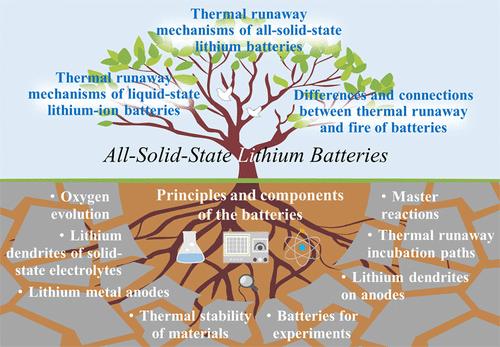Research Progress on Thermal Runaway Mechanisms of All-Solid-State Lithium Batteries
IF 18.2
1区 材料科学
Q1 CHEMISTRY, PHYSICAL
引用次数: 0
Abstract
Despite their various advantages, all-solid-state lithium batteries (ASSLBs) remain vulnerable to thermal runaway (TR), and the mechanisms are covered in fog. Safety theories and methods applicable to liquid-state lithium-ion batteries (LSLIBs) cannot be transferred to ASSLBs directly. Therefore, this review discusses the distinction and connection between fire and TR of batteries and their definitions. The structures, components, and materials of the two batteries are then compared. Furthermore, the temperature nodes, reactions, and driving forces of TR from overcharged LSLIBs are interpreted. Based on the above content, this paper dissects the principles, areas, and laws of TR of ASSLBs, followed by discussing similarities and differences between the LSLIB and ASSLB regarding TR. In the final part, future development directions and research ideas for improving the safety of ASSLBs are proposed. This review provides a fundamental understanding of TR issues hidden in ASSLBs and accelerates this new battery’s interdisciplinary research.

全固态锂电池热失控机理研究进展
尽管具有各种优势,但全固态锂电池(asslb)仍然容易受到热失控(TR)的影响,其机制尚不清楚。适用于液态锂离子电池(lslib)的安全理论和方法不能直接转移到asslb。因此,本文讨论了火灾与电池TR的区别和联系以及它们的定义。然后比较两种电池的结构、组件和材料。此外,还解释了过充电lslib的温度节点、反应和TR的驱动力。在以上内容的基础上,本文剖析了ASSLB的TR原理、领域和规律,讨论了LSLIB和ASSLB在TR方面的异同。最后提出了ASSLB未来的发展方向和提高安全性的研究思路。本综述为asslb中隐藏的TR问题提供了基本的认识,并加速了这种新型电池的跨学科研究。
本文章由计算机程序翻译,如有差异,请以英文原文为准。
求助全文
约1分钟内获得全文
求助全文
来源期刊

ACS Energy Letters
Energy-Renewable Energy, Sustainability and the Environment
CiteScore
31.20
自引率
5.00%
发文量
469
审稿时长
1 months
期刊介绍:
ACS Energy Letters is a monthly journal that publishes papers reporting new scientific advances in energy research. The journal focuses on topics that are of interest to scientists working in the fundamental and applied sciences. Rapid publication is a central criterion for acceptance, and the journal is known for its quick publication times, with an average of 4-6 weeks from submission to web publication in As Soon As Publishable format.
ACS Energy Letters is ranked as the number one journal in the Web of Science Electrochemistry category. It also ranks within the top 10 journals for Physical Chemistry, Energy & Fuels, and Nanoscience & Nanotechnology.
The journal offers several types of articles, including Letters, Energy Express, Perspectives, Reviews, Editorials, Viewpoints and Energy Focus. Additionally, authors have the option to submit videos that summarize or support the information presented in a Perspective or Review article, which can be highlighted on the journal's website. ACS Energy Letters is abstracted and indexed in Chemical Abstracts Service/SciFinder, EBSCO-summon, PubMed, Web of Science, Scopus and Portico.
 求助内容:
求助内容: 应助结果提醒方式:
应助结果提醒方式:


